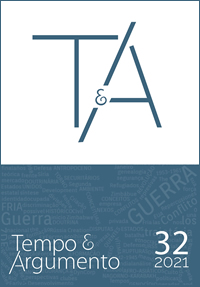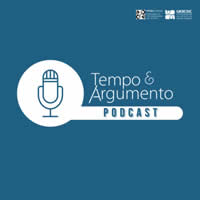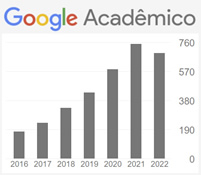The trajectory of the heavy divisions of USSR/Russia and of the USA at the start and end of the Cold War
DOI:
https://doi.org/10.5965/2175180313322021e0106Abstract
This article presents and discusses the path that led to the organizational designs of the heavy division of the USSR and the USA at the start and at the end of the Cold War. It explains modern combined arms centred on the tank, and the central role of the army division (10,000-20,000 combatants) for the provision of the different types of troops required to have them when necessary. It then addresses the tank and mechanized corps of the USSR and the armored division in 1945, outlining how these led to the motor rifle and tank divisions of the USSR and the armored and mechanized divisions of the USA c. 1985, as proxy for 1991 to account to the turbulence at the end of the Cold War. It argues in conclusion for the continuity and prevalence of the issue of providing for combined arms centred on the tank in the division as the prime concern for the organizational design of ground forces to the present.
Downloads
References
ALLEN, Matthew. Military helicopter doctrines of the major powers, 1945-1992. Westport: Greenwood Press, 1993.
ATKINSON, Rick. An army at dawn: the war in North Africa, 1942-1943. New York: Henry Holt and Co., 2002.
BAILEY, Jonathan B. A. Field artillery and firepower. Annapolis: US Naval Institute Press, 2003.
BAXTER, William P. Soviet airland battle tactics. Novato: Presidio Pr., 1986.
BELLAMY, Chris. Absolute war: Soviet Russia in the Second World War. Vancouver: Vintage, 2008.
BELLAMY, Chris. The evolution of modern land warfare: theory and practice. London: Routledge, 2015.
BOYNE, Walter J. How the helicopter changed modern warfare. Gretna: Pelican Publishing, 2011.
BROWN, John Sloan. Kevlar legions: the transformation of the U.S. Army, 1989–2005. Washington: Center of Military History, 2011.
CANCIAN, Mark F. US military forces in FY 2021: army. Washington: CSIS, 2020.
COAKLEY, Robert W; LEIGHTON, Richard M. Global logistics and strategy, 1943-1945. Washington: Office of the Chief of Military History: United States Army, 1968.
COCKBURN, Andrew. The threat: inside the Soviet military machine. London: Random House, 1983.
CORDESMAN, Anthony H; WAGNER, Abraham. The lessons of modern war: the Gulf War. Boulder: Westview, 1996.
CRANE, Keith; OLIKER, Olga; NICHIPORUK, Brian. Trends in Russia’s armed forces: an overview of budgets and capabilities. Santa Monica: RAND, 2019.
CSI. Combat Studies Institute. Sixty years of reorganizing for combat: a historical trend analysis. Fort Leavenworth: Combat Studies Institute, 1999.
DAVIES, R. Mark et al. USA 1980s TO&Es: v 2.7. Ocean Isle Beach: Fire and Fury Games, 2019.
DEIGHTON, Len. Blitzkrieg: from the rise of Hitler to the fall of Dunkirk. [S.l.]: Castle, 2000.
DELBRÜCK, Hans. The dawn of modern warfare: history of the art of war. Lincoln: University of Nebraska Press, 1990. v. 1.
DUNNIGAN, James F. Organization of Soviet Ground Forces. In: STAFF, S.; STAFF, T. (eds.). The war in the East. New York: SPI, 1977. p. 105-125.
DUNNIGAN, James F.; MACEDONIA, Raymond M. Getting it right: American military reforms after Vietnam to the Gulf War and beyond. 2. ed. New York: William Morrow & Co, 2001.
DUPUY, Trevor Nevitt. The evolution of weapons and warfare. Boston: Da Capo Press., 1990.
EDGERTON, David. Britain's war machine: weapons, resources and experts in the Second World War. London: Allen Lane, 2011.
ELLIS, John. The World War II databook: the essential facts and figures for all the combatants. London: Aurum Press, 1993.
ENGLISH, John A.; GUDMUNDSSON, Bruce I. On infantry. 2. ed. Westport: Praeger, 1994.
ERICKSON, John; HANSEN, Lynn; SCHNEIDER, William P. Soviet ground forces: an operational assessment. London: Routledge, 2019.
EVANS, Michael. General Monash's orchestra: reaffirming combined arms warfare. In: EVANS, Michael; RYAN, Alan. From Breitenfeld to Baghdad: perspectives on combined arms warfare. Duntroon: Land Warfare Studies Centre, 2003. p. 1-26.
FLANAGAN, Stephen J. et al. Deterring Russian aggression in the Baltic States through resilience and resistance. Santa Monica: Rand, 2019.
FRIEDMAN, Norman. The Fifty-Year War: conflict and strategy in the Cold War. Annapolis: Naval Institute Press, 2007.
GALEOTTI, Mark. The modern Russian army 1992–2016. Oxford: Osprey, 2017.
GILLIE, Mildred Hanson. Forging the thunderbolt: a history of the development of the armored force. Washington: Military Service Publishing, 1947.
GLANTZ, David M. Soviet Force Structure in an Era of Reform. The Journal of Soviet Military Studies, [S.l.], v. 2, n. 3, p. 361-93, 1989.
GLANTZ, David M. Soviet military operational art: in pursuit of deep battle. London: Frank Cass, 1991a.
GLANTZ, David M. The Soviet conduct of tactical maneuver: spearhead of the offensive. London: Routledge, 1991b.
GLANTZ, David M. The military strategy of the Soviet Union: a history. London: Routledge, 2001.
GLANTZ, David M. The Soviet strategic offensive in Manchuria, 1945: August Storm. London: Routledge, 2003.
GLANTZ, David M. The Development of the Soviet and Russian Armies in Context, 1946–2008: A Chronological and Topical Outline. The Journal of Slavic Military Studies, [S.l.], v. 23, n 1, pp. 27–235, 2010.
GLANTZ, David M et al. Slaughterhouse: the handbook of the Eastern front. Bedford: The Aberjona Press, 2004.
GLANTZ, David M.; HOUSE, Jonathan M. When titans clashed: how the red army stopped Hitler, revised and expanded edition. Lawrence: University Press of Kansas, 2015.
GREENFIELD, Kent; PALMER. Robert R; WILEY, Bell I. The army ground forces: the organization of ground combat troops. Washington: Center of Military History, 1987.
GROPMAN, Alan. Introduction. In: GROPMAN, Alan (ed.). The big “L”: American logistics in World War II. Washington: GPO, 1997. p. ix-xii.
GUDMUNDSSON, Bruce I. On artillery. Westport: Praeger, 1993.
GUDMUNDSSON, Bruce I. On armor. Westport: Praeger, 2004.
GUNSTON, Bill. Modern fighting helicopters. London: Salamander, 1999.
HANSON, Philip. The rise and fall of the Soviet economy: an economic history of the USSR 1945-1991. London: Pearson Education Limited, 2003.
HAWKINS, Glen R. US army force structure and force design initiatives 1939-1989. Washington: US Center for Military History, 2013.
HAWKINS, Glen R.; CARAFINO, Jay. Prelude to army XXI: U.S. army division design initiatives and experiments, 1917-1995. Washington: Center of Military History, 1997.
HAYTHORNTHWAITE, Phillip J. The napoleonic sourcebook. London: Arms and Armour Press, 1997.
HERBERT, Paul H. Deciding what has to be done: General William E. DePuy and the 1976 edition of FM 100-5, operations. Fort Leavenworth: Combat Studies Institute, 1988.
HOUSE, Jonathan M. Toward combined arms warfare: a survey of 20th-Century tactics, doctrine, and organization. Honolulu: University Press of the Pacific, 2002.
HOUSE, Jonathan M. A military history of the Cold War, 1962–1991. Norman: University of Oklahoma Press, 2020.
IISS. The International Institute for Strategic Studies. The military balance 2016. London: Routledge, 2016.
ISBY, David C. Weapons and tactics of the Soviet army. London: Jane's, 1988.
JARYMOWYCZ, Roman. Tank tactics: from Normandy to Lorraine. Mechanicsburg: Stackpole, 2008.
JORDAN, David et al. Understanding modern warfare. 2. ed. Cambridge: Cambridge University Press, 2016.
KEDZIOR, Richard W. Evolution and endurance: the U.S. army division in the 20th Century. Santa Monica: Rand Publishing, 2000.
LEIGHTON, Richard M.; COAKLEY, Robert W. Global logistics and strategy, 1940-1943. Washington: Office of Chief of Military History, 1955.
MCCONVILLE, James C. Army multi-domain transformation. Washington: Headquarters: Department of the Army, 2021. (Chief of Staff Paper #1).
MACGREGOR, Douglas A. Breaking the phalanx: a new design for landpower in the 21st Century. 3. ed. Westport: Praeger, 1997.
MACGREGOR, Douglas A. Transformation under fire: revolutionizing how America fights. Westport: Praeger, 2003.
MANDELES, Mark. The future of war: organizations as weapons. Washington: Potomac Books, 2005.
MARTYANOV, Andrei. Losing military supremacy: the myopia of American strategic planning. Atlanta: Clarity, 2018.
MCGOWEN, Stanley S. Helicopters: an illustrated history of their impact. Santa Barbara: ABC-CLIO, 2005.
MILLER, Christopher F. Modern land combat. London: Salamander, 2001.
O’HANLON, Michael E. The science of War: defense budgeting, military technology, logistics, and combat outcomes. Princeton: Princeton University Press, 2009.
OHL, John Kennedy. Supplying the troops: General Somervell and American logistics in World War II. Ithaca: Cornell University Press, 2020. E-book.
REESE, Roger R. The Soviet military experience: a history of the Soviet army, 1917-1991. London: Routledge, 2000.
RENZ, Bettina. Russia’s military revival. Cambridge: Polity, 2018. E-book.
ROMJUE, John. From active defense to airland battle: Development of Army Doctrine 1973-1982. Fort Monroe: TRADOC, 1985.
ROMJUE, John. The army of excellence: the development of the 1980s army. Ft. Monroe, VA: TRADOC, 1997.
ROTTMAN, Gordon L. Inside the US army. Oxford: Osprey, 1988.
ROTTMAN, Gordon L. World War II combat reconnaissance tactics. Oxford: Osprey, 2007.
ROTTMAN, Gordon L. World War II infantry assault tactics. Oxford: Osprey, 2008.
ROTTMAN, Gordon L. World War II US armored infantry tactics. Oxford: Osprey, 2011.
SKINNER, Michael. USAREUR: the United States army in Europe. Novato: Presidio, 1989.
STEWART, Richard W. American military history volume 2: the United States army in a global era, 1917-2010. 2. ed. Alexandria: St John’s Press, 2010.
SUTYAGIN, Igor; BRONK, Justin. Russia’s new ground forces. Abingdon: Routledge, 2017.
US ARMY. FM 100-5 operations. Washington: GPO, 1976.
US ARMY. FM 100-2-1 the Soviet Army, operations and tactics. Washington: GPO, 1984.
US ARMY. FM 100-2-3 the Soviet army: troops, organization and equipment. Washington: GPO, 1991.
TUCK, Christopher. Understanding land warfare. Abingdon: Routledge, 2014.
VVAA. Soviet TO&Es 1980-1989: v 1.9. Ocean Isle Beach: Fire and Fury Games, 2011.
WILSON, John H. Maneuver and firepower: the evolution of divisions and separate brigades. Washington: Center of Military History: US Army, 1998.
ZALOGA, Steven J. Tank war-central front. Oxford: Osprey Publishing, 1989.
ZALOGA, Steven J. US armored divisions: the European theater of operations, 1944–45. Oxford: Osprey Publishing, 2004.
ZALOGA, Steven J. US armored units in the North Africa and Italian campaigns 1942-45. Oxford: Osprey Publishing, 2006.
ZALOGA, Steven J. US field artillery of World War II. Oxford: Osprey Publishing, 2011.
ZALOGA, Steven J; NESS, Leland S. The red army handbook, 1939-1945. Stroud: Sutton Publishing, 1998.
Downloads
Published
How to Cite
Issue
Section
License
Copyright (c) 2021 Tempo e Argumento

This work is licensed under a Creative Commons Attribution-NonCommercial 4.0 International License.
The articles published by the magazine are for free use, destined for educational purposes and not commercial. The copyrights are all granted to the magazine. The articles whose authors are identified represent the expressed opinion of its authors and not the official position of the Tempo e Argumento magazine or of the Postgraduate Program in History of the Universidade do Estado de Santa Catarina.




